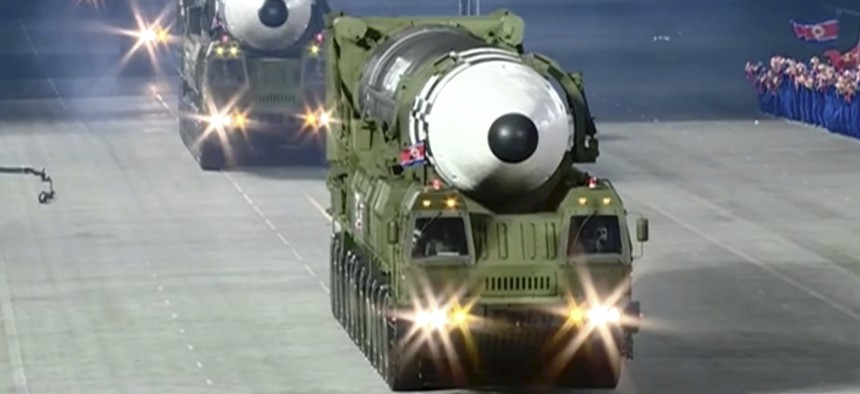
This image made from video broadcasted by North Korea's KRT, shows a military parade with what appears to be a possible new solid-fuel missile at the Kim Il Sung Square in Pyongyang, Saturday, Oct. 10, 2020. KRT via AP
North Korea Unveils ‘Very Destabilizing’ ICBM
Pyongyang’s new missile boosts the chance of conflict, even if it doesn’t work.
Two ballistic missiles made their debut in Saturday’s North Korean military parade: a sub-launched weapon and what appeared to be an enormous new intercontinental ballistic missile borne on a long, 11-axle mobile launcher. Analysts have long scrutinized Pyongyang’s parades for what they reveal about the military capabilities of one of the world’s most secretive regimes — but the Oct. 10 event also offered the latest and clearest signal yet that the Trump administration’s efforts to curb North Korea’s nuclear ambitions have failed. One expert called the new ICBM a destabilizing capability that would exacerbate tensions between North Korea and the rest of the world, particularly the United States.
The new ICBM isn’t exactly a surprise, said Jeffrey Lewis, a scholar at the Middlebury Institute of International Studies at Monterey and the founding publisher of the Arms Control Wonk blog. North Korea tested liquid-fuel rockets last December at the vertical engine test stand at the Sohae testing site. “It was a really big test. They bothered to announce it. But for whatever reason,” it didn’t get much coverage in international media, Lewis said.
Lewis believes that the missile is intended to carry multiple warheads, another new capability. That means North Korea is improving the likelihood of slipping a nuclear weapon past the ground-based midcourse defense interceptors that the United States would deploy against an incoming ICBM.
“It’s so much cheaper to add warheads than interceptors,” said Lewis.
He acknowledged that the missile hasn’t been flight-tested yet, so there’s no way to tell if it actually works. But it need not be 100-percent reliable to post a large threat that could change U.S. calculations. “We are standing by while they deploy very destabilizing capabilities,” he said.
MIT associate professor Vipin Narang echoed Lewis’ analysis that the ICBM was no surprise, and that it was likely intended to deliver multiple defense-thwarting warheads. “Be thankful we didn’t see a solid fuel ICBM!” tweeted Narang, a member of MIT’s Security Studies Program.
The new weapons underscore the failure of Trump administration efforts to de-escalate tensions with North Korea. As a candidate, Donald Trump vowed to keep Pyongyang from developing a nuclear weapon capable of hitting the United States; one year into his presidency, he reiterated his promise:
“North Korea just stated that it is in the final stages of developing a nuclear weapon capable of reaching parts of the U.S. It won't happen!”
North Korea just stated that it is in the final stages of developing a nuclear weapon capable of reaching parts of the U.S. It won't happen!
— Donald J. Trump (@realDonaldTrump) January 2, 2017
Fast-forward to Saturday. “Trump’s failed negotiations and false promises on full display in Pyongyang as North Korea parades massive 11-axle missile launcher,” tweeted Hans Kristensen, director of the Nuclear Information Project at the Federation of American Scientists. (He also cautioned against assuming that the size of the missile was directly related to accomodating multiple warheads.)
Trump’s failed negotiations and false promises on full display in Pyongyang as North Korea parades massive 11-axle missile launcher. I would caution on speculations about MIRV. More likely about large size of possible thermonuclear warhead. https://t.co/L3wCO1dDld
— Hans Kristensen (@nukestrat) October 10, 2020
Lewis, no fan of the North Korean regime, blamed the failure of nuclear talks on the Trump administration. “The deal the North Koreans were negotiating for...they never said they would give up their nuclear weapons…only stop brandishing them,” he said. “To me, their messages have been consistent.”
In effect, the North Koreans were pushing for an understanding similar to the one the United States has with Israel, where Israel does not conduct obvious tests or allow photos of nuclear weapons to reach the public, thus leaving open the question of whether they actually exist. A similar deal with North Korea would do much to de-escalate the current situation.
If Washington does not find a way to restart talks, Lewis said, Pyongyang will continue to develop weapons that put U.S. forces and territory more and more at risk — and therefore continue to raise the incentive for the U.S. to strike preemptively. That reality is surely a part of the North Korean calculus as well, said Lewis, who has written a novel about a North Korean regime concluding that it must launch nuclear weapons to survive..
“We should not be allowing a situation to exist in which there are strong incentives to go first” into conflict, he said.




